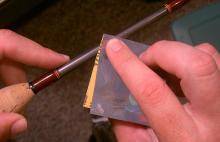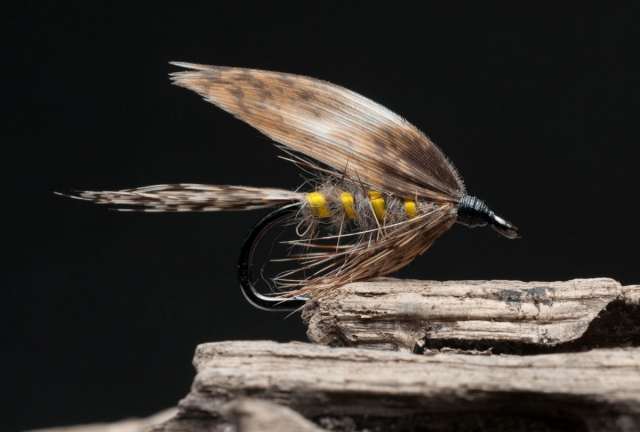Writing on rods
One of the hallmarks of rod builder Dave Lewis' work is the handwritten details on each rod. The writing is done by Dave's wife Mary Lu and in this article Dave briefly explains how to obtain the best results when writing on rods.
Over the many years the writing on my rods has gotten more notice than any other one thing. The number one question I get about my rods is "How do you do the writing?" and "What do you use to do the writing with."
We got on to our current formula many years ago and have stuck with it.
Lots of paints work well.
I always suggest hobby paint or various colors of correction fluid. Folks have used white shoe polish, acrylic paint, powdered water color paints, tempra, and a whole host of others.
But the one main key to it is technique, I guess. My wife Mary Lu, who does all the writing on our rods, is very meticulous and very persistent.
The pen used
is an old fashioned quill pen. You can see in the background the mixing cups Mary Lu uses to mix the inks she uses.
You will note that the color is the same as the trim wrap I use on the rod. We always try and match the writing color to the trim wrap. You can see that the pen tip is quite small. Mary Lu uses a small brush to fill the pen.
I have all the info
written down on a sheet for her to use while she writes.
She always cautions me to read over the rod after she is done because she some times writes the wrong thing and I some times give her the wrong thing to write.
I scuff the writing area
with steel wool first and clean the area with solvent previous to her doing the writing. I follow up with a clear coat over the writing with polyurethane.
The gold and white are opaque enough to use at least on gray blanks, but the other colors are really quite transparent. I would never use any gold or silver metalic stuff on my rods, though. That would clash with my style. If you look at some pictures of my rods you will realize that the colors we use are not gold or white, but lots of in between colors. Those colors are best mixed up from quite opaque paints. When all graphite blanks were gray, you could write on them with India ink, even, and it would show. Now practically all blanks are much darker colors and writing needs to be much lighter and more opaque to show up.
I never clear coat with epoxy
. It creates a very heavy, burried under glass, three inches long area ahead of the grip. That is so "factory" and so tacky looking. I clear coat with one coat of polyurethane. The resulting coverage is so thin that the paint of the letters is raised within the finish and can be seen as a relief. It is all part of a style that I have stuck with and has become part of my identity as a rod builder.
Craftsmanship is of utmost importance in any endeavor that falls under the broad category of aesthetics, but ask any artist and he will tell you that it is his style that makes his stuff special.
Sadly, Dave Lewis has passed away, and his company is no longer active.
Phone (US): 540/867-0856
You can still find some of his rods here Dave Lewis/Performance Fly Rods
Addendum
Writing on rods
is tricky business. If a person doesn't have good penmanship, they are probably better served getting decals made from a place such as Decal Connection where they can make as many or as few decals you want for excellent prices. I was blessed with decent writing skills, so I enjoy putting my own personal touch on a new rod by doing the writing myself. After a lot of false starts with various techniques, I've finally settled on one that works for me.
The writing instrument
I use is a cheap craft store gel pen - my brand is "Gelly Roll" - in either silver or gold. They come in a zillion colors, however, so get what you want. Not all pens work the same - some will skip or false start on the blank and not flow smoothly - but they are cheap enough to try a few brands until you get one you like. The pens I have write perfectly on the blank once it has been deglossed with a bit of 1000-grit wet/dry sandpaper.
The process
goes something like this:
- Practice writing what you want to write a few times on a piece of paper to gauge the length of the space you need on the rod, the placing of things if you are going to have multiple lines, and also the height of the lettering. You don't want to practice on the rod itself, for obvious reasons.
- Once you've settled on how you want it to look on paper, scuff up the blank with the 1000 grit just to take the shine off and prepare a surface to accept the ink. Don't go nuts. For gloss blanks - you just want to remove the gloss. For matte finished blanks - it might not even be necessary but a few gentle swipes won't hurt.
- To help make the writing feel as natural as possible, I lay the blank flat on a table and then put a thin book or a couple magazines up against the blank so my wrist is at the same level as the blank. Writing on a round surface is tricky - especially for the big swoopy letters like "g" or "f" which want to run off the blank - so anything you can do to make it feel more like writing on a flat surface the better the results will be.
- With gel pens, you get a few cracks at it where you can wipe off your mistakes with a wet paper towel. Don't go crazy, though, or you risk smearing some of the ink and creating a foggy "smudge" area that may show up after you put the finish on. If you screw up a few times, break down and get out a good cleaning solvent and start over from scratch.
- Ok, so once the writing is on the rod the way you want it, the next step is to make it smudge and solvent resistant. I use a Krylon brand spray fixative to accomplish this, protecting the rest of the blank with some newspapers while spraying. One coat with this and the writing is safe from smudges and somewhat resistant to solvents - at least those in the final coating I use.
- For awhile, that's where I ended things, as the spray-on fixative seemed to be durable enough if you kept care of your equipment. However, on an old broken rod, I attacked some old writing with a thumbnail and was able to scratch it off with some effort, so I decided to add a bit more protection. My goal is to make it look as if there is no coating over the writing at all, so a thick band of epoxy was out. A wipe-on polyurethane is perfect, and since it comes in both glossy and matte you can match the finish to the blank almost perfectly. I've done a few matte finished blanks with the writing coated with matte poly and you can't tell the coating is there at all. Perfect. In the rod pictured here I coated the writing with gloss to ease the transition between the two thread trim rings.
- So I get the rod turning, soak a small section of wiping rag with the poly and just hold it over the spot while the rod is turning, being careful to get total coverage. Once the area is wet, walk away for an hour or so until it dries. Three coats and I'm good to go.
Read more about why you should register.
More content from the front page
Since you got this far …
… I have a small favor to ask.
Long story short
Support the Global FlyFisher through several different channels, including PayPal.
Long story longer
The Global FlyFisher has been online since the mid-90's and has been free to access for everybody since day one – and will stay free for as long as I run it.
But that doesn't mean that it's free to run.
It costs money to drive a large site like this.
See more details about what you can do to help in this blog post.








































































Comments
Wonderful work. I h
Wonderful work. I have been trying to find the correct pen and ink to do the job without much success. Can you tell me what pen(s) you use and what do you use for ink. I have seen and read several articles about using paints that seem to work pretty well.
Thanks and again beautifule work
hi dave, your wife
hi dave,
your wife does some really beautyful calligraphy on those rods! i'll be trying to stick to your tips for my next projects, unfortunately minwax products aren't available in europe... do you have any recommendations on alternatives, maybe some kind of PU based yacht-/boat-varnish might do the job as well?
THX*
joi
Do you know how to r
Do you know how to remove manufactur's writing on rods?
Bob, I've been havi
Bob,
I've been having difficulty with signing a graphite rod that I've just made (have spent more time on the signature and data than it took to make the entire rod, ...pretty sad).
1. I was wondering how long it takes for the 'Gelly Roll' gold writing to dry enough so that it doesn't end up dissolving into the Krylon, or is this not an issue? I have tried using a PENTEL Hybrid K105x gold gel pen, but the ink didn't seem to dry enough. When I tried coating it with U40 Super Urethane I found that some of the gold emulsion dissolved into the urethane.
2. Have you ever tried spray-on polyurethane without the Krylon fixative? Do you know if this works?
Thanks in advance for any advice you can offer.
Fantstic article and
Fantstic article and web site. I teach rod building classes here, and with permission, will use your article on signing a rod. My only question is what to you use when writing. I've tried some white paint from a model shop, and that wasn't the best. Suggestions?
I'm making Bamboo ro
I'm making Bamboo rods now and the signature on the rods is always a moment of stress. My compliments - an excellent job!
Your rods have alway
Your rods have always been the gold standard, Dave. Every detail has been given proper attention.